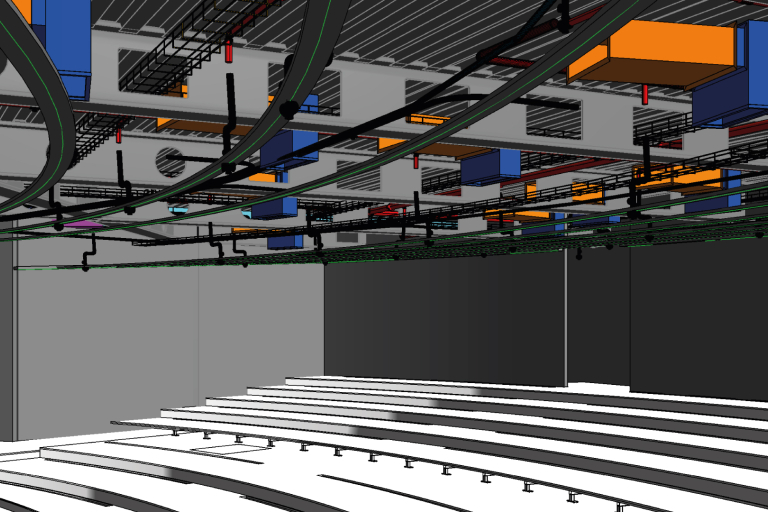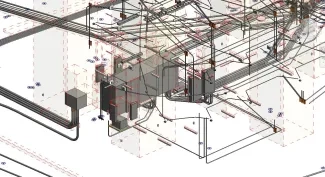In today's fast-paced construction industry, efficiency and cost-effectiveness are paramount concerns for stakeholders at every stage of a project. Fortunately, advancements in technology have provided innovative solutions to streamline processes and optimize outcomes. Among these solutions, Electrical Building Information Modeling (BIM) services stand out as a game-changer. By harnessing the power of digital modeling, Electrical BIM services offer a transformative approach to electrical design and installation, promising reduced costs and seamless integration throughout the construction process. In this blog post, we'll delve into the intricacies of Electrical BIM modeling services, exploring how they enable stakeholders to achieve significant cost savings while ensuring a smooth and efficient electrical installation process.
Understanding Electrical BIM Modeling Services
Building Information Modeling (BIM) is a digital representation of physical and functional characteristics of places. Electrical BIM Modeling Services specifically cater to the electrical systems within buildings, providing a comprehensive digital model of electrical components and systems. This includes lighting, power distribution, fire alarm systems, telecommunications, and other electrical infrastructure.
The Evolution of Electrical Design and Construction
Traditionally, electrical design and construction processes were fragmented and often led to inefficiencies, errors, and cost overruns. Communication gaps between architects, engineers, contractors, and subcontractors were common, leading to conflicts and rework during construction.
Electrical BIM Modeling Services address these challenges by enabling stakeholders to collaborate effectively through a shared digital platform. The model serves as a single source of truth, providing accurate and up-to-date information throughout the project lifecycle
Sparking a New Era: How BIM Revolutionizes Electrical Design
The world of electrical design is experiencing a tectonic shift, and the catalyst is Building Information Modeling (BIM). This innovative technology is no longer a futuristic buzzword; it's reshaping how electrical systems are conceived, designed, and implemented, bringing a wave of benefits that ripple across the entire construction process.
Precision & Clarity
Gone are the days of hand-drawn schematics and siloed information. BIM offers a single, centralized, and 3D model of the entire building, incorporating every element, including the electrical system. This level of detail fosters precision and clarity, preventing costly errors and rework due to miscommunication. Imagine visualizing cable pathways weaving through walls, avoiding clashes with other systems, all before a single wire is laid.
Enhanced Collaboration
BIM acts as a digital bridge, connecting architects, engineers, and contractors in a collaborative environment. Electrical designers can visualize their systems in context with the entire building, ensuring seamless integration with other disciplines and minimizing costly clashes later on. Imagine architects planning window placements around electrical conduits, or HVAC engineers routing ducts to avoid electrical panels – all within the same virtual model.
Optimized Design & Performance
BIM isn't just about visualization; it's about analysis and optimization. Powerful software tools embedded within BIM platforms allow engineers to simulate circuit loads, analyze energy consumption, and optimize system performance. This data-driven approach leads to efficient designs, minimized energy waste, and reduced operational costs. Picture analyzing different wiring configurations and choosing the one that minimizes energy loss before the first light switch is installed.
Clash Detection & Conflict Resolution
In the traditional process, hidden clashes between electrical systems and other building elements often become unpleasant surprises during construction. BIM eliminates this headache by offering comprehensive clash detection capabilities. The software proactively identifies potential conflicts, allowing engineers to resolve them virtually before they become problematic and expensive to fix on site. Imagine catching a potential pipe collision with your electrical conduit before the concrete gets poured, saving time, money, and frustration.
Improved Documentation & As-builts
BIM generates accurate and comprehensive documentation of the electrical system as it evolves. This data becomes invaluable for future maintenance, troubleshooting, and potential renovations. No more digging through stacks of paper schematics; BIM models serve as a living digital record, readily accessible and up-to-date. Think of having a detailed electrical map at your fingertips whenever you need to add a new outlet or diagnose a power outage.
By embracing this transformative technology, electrical design is no longer stuck in the shadows; it's taking center stage, illuminating a future of increased efficiency, collaboration, and innovation. So, step into the light and let BIM guide you as you spark a new era of electrical design.

Read more: Take Advantage of Revit for Plumbing BIM Modeling to Easily Install MEP
Electrical BIM Modeling Process
Step 1: Getting the Blueprint Right
Electrical BIM starts by collecting important information: architectural models, electrical drawings, and equipment specs. Every little detail, from where to put panels to how long cables should be, is the basis for creating a virtual world.
Step 2: Making Things Look Good (in a Good Way!)
This is where the cool stuff happens! Electrical things like panels, switches, pipes, and even lights are carefully placed in a 3D model. Imagine cables moving smoothly through walls and ceilings, not stuck in flat drawings. This visual harmony is where we find and fix possible problems, like wires in the wrong places, before they become real issues.
Step 3: Adding Smarts to Every Wire
BIM isn't just about making things look nice; it's about putting smart stuff into every digital piece. Electrical things are given data like voltage, amperage, and circuit types. This info becomes the heart of the model, letting us do simulations, find problems, and even figure out how much things will cost.
Step 4: Let's Pretend!
Remember all that smart information? Now, it's time to see it in action! BIM software lets us pretend real-life situations, like making sure everything has power and lights up correctly. It's like trying out your design on a computer before building it, so we can fix problems before they happen.
Step 5: Collaboration
BIM isn't a one-person job; it's like a team playing music together. The electrical plan becomes a shared space for architects, builders, and experts to work together and find problems. No more surprises at the last minute; BIM makes things clear and helps everyone stay on the same page.
Step 6: From Computer to Real Life
Once the virtual design is done, it's time to make it real. BIM helps create detailed drawings and plans for builders. This makes construction smoother, and it lets them build some things off-site, which saves time and reduces mistakes.
Real-Life Examples: BIM in Action!
Now, let's look at how BIM helps in real life:
Burj Khalifa, Dubai: The tallest building used BIM to plan its electrical systems, making sure everything worked well. Imagine trying to figure out 163 floors of wires without BIM – not a fun task!
Stanford Medical Center, California: This big hospital saved money and energy by using BIM to plan its electrical design. Think of a hospital having more money for life-saving equipment, all thanks to BIM!
Denver International Airport, Colorado: BIM helped plan the electrical systems in the airport's new building, making things run smoothly. Picture a busy airport working well – that's what BIM can do!

Read more: Different Types of Mechanical, Electrical, and Plumbing - MEP Drawings
Why Opt for Our Electrical BIM Modeling Services
With more than 20 years providing all services related to BIM/ CIM modeling for construction industry, especially MEP modeling services, we are confident when saying that Harmony AT has:
Unparalleled Expertise
Our team isn't just technically skilled; they're passionate about electrical design and BIM. We bring years of experience, a deep understanding of industry best practices, and a commitment to exceeding expectations. Trust us to be your trusted partner, guiding you through every stage of the electrical BIM process, from initial concept to final installation.
Beyond the Basics
We don't stop at the fundamentals. Our team is constantly exploring the cutting edge of BIM technology, incorporating tools like virtual reality (VR) walkthroughs and prefabrication drawings to further enhance efficiency and accuracy. Imagine stepping into a virtual replica of your building before a single brick is laid, refining your electrical design and ensuring flawless execution.
Reduced Rework
Mistakes are costly, but with BIM, they're easily avoided. Our detailed models and clash detection capabilities minimize the need for costly rework, ensuring your project stays on track and within budget. Imagine eliminating the frustrating rework loop and seeing your project unfold exactly as planned.
Cutting-edge Technology
We invest in the latest BIM software and hardware, providing you with access to the most advanced tools and capabilities.
Tailored Solutions
We understand no two projects are the same. We work closely with you to develop customized BIM solutions that meet your specific needs and goals.
Choosing our electrical BIM modeling services is not just an investment in technology; it's an investment in the future of your project. We empower you to spark innovation, optimize performance, and build with confidence. So, why settle for the ordinary when you can ignite your project's potential with the brilliance of BIM?
Our Electrical BIM Modeling Services Include
Accurate 3D Electrical Models: Our 3D modeling services create precise and clear electrical models using Revit, ensuring trouble-free installation for contractors and consultants.
Efficient Coordination Solutions: We offer clash detection and coordination services to optimize the functioning of electrical systems, enhancing efficiency and safety in power distribution networks.
Detailed Fabrication Drawings: Our shop drawings provide detailed visual representations of electrical elements, serving as valuable tools for contractors, consultants, and fabricators during installation.
Precise Quantity Take-Off Services: With our Electrical Quantity Take-Off (QTO) services, we provide accurate bill of materials (BOM), helping contractors forecast overall costs during the bidding stage for informed decision-making.
For any questions left, contact us here. See you!
Categories





